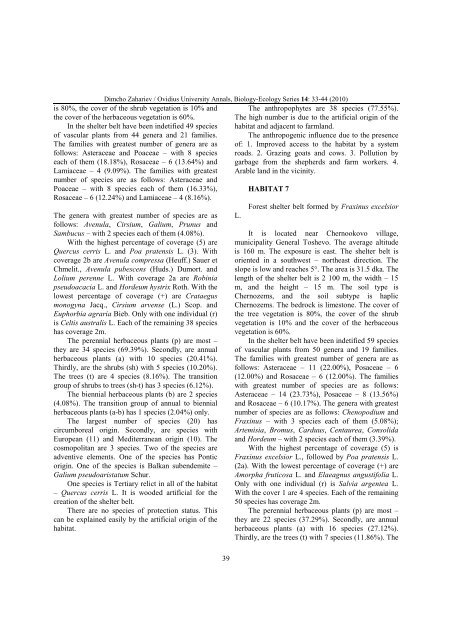VOLUM OMAGIAL - Facultatea de Ştiinţe ale Naturii şi Ştiinţe Agricole
VOLUM OMAGIAL - Facultatea de Ştiinţe ale Naturii şi Ştiinţe Agricole
VOLUM OMAGIAL - Facultatea de Ştiinţe ale Naturii şi Ştiinţe Agricole
You also want an ePaper? Increase the reach of your titles
YUMPU automatically turns print PDFs into web optimized ePapers that Google loves.
Dimcho Zahariev / Ovidius University Annals, Biology-Ecology Series 14: 33-44 (2010)<br />
is 80%, the cover of the shrub vegetation is 10% and<br />
the cover of the herbaceous vegetation is 60%.<br />
In the shelter belt have been in<strong>de</strong>tified 49 species<br />
of vascular plants from 44 genera and 21 families.<br />
The families with greatest number of genera are as<br />
follows: Asteraceae and Рoaceae – with 8 species<br />
each of them (18.18%), Rosaceae – 6 (13.64%) and<br />
Lamiaceae – 4 (9.09%). The families with greatest<br />
number of species are as follows: Asteraceae and<br />
Рoaceae – with 8 species each of them (16.33%),<br />
Rosaceae – 6 (12.24%) and Lamiaceae – 4 (8.16%).<br />
The genera with greatest number of species are as<br />
follows: Avenula, Cirsium, Galium, Prunus and<br />
Sambucus – with 2 species each of them (4.08%).<br />
With the highest percentage of coverage (5) are<br />
Quercus cerris L. and Poa pratensis L. (3). With<br />
coverage 2b are Avenula compressa (Heuff.) Sauer et<br />
Chmelit., Avenula pubescens (Huds.) Dumort. and<br />
Lolium perenne L. With coverage 2a are Robinia<br />
pseudoacacia L. and Hor<strong>de</strong>um hystrix Roth. With the<br />
lowest percentage of coverage (+) are Crataegus<br />
monogyna Jacq., Cirsium arvense (L.) Scop. and<br />
Euphorbia agraria Bieb. Only with one individual (r)<br />
is Celtis australis L. Each of the remaining 38 species<br />
has coverage 2m.<br />
The perennial herbaceous plants (p) are most –<br />
they are 34 species (69.39%). Secondly, are annual<br />
herbaceous plants (a) with 10 species (20.41%).<br />
Thirdly, are the shrubs (sh) with 5 species (10.20%).<br />
The trees (t) are 4 species (8.16%). The transition<br />
group of shrubs to trees (sh-t) has 3 species (6.12%).<br />
The biennial herbaceous plants (b) are 2 species<br />
(4.08%). The transition group of annual to biennial<br />
herbaceous plants (а-b) has 1 species (2.04%) only.<br />
The largest number of species (20) has<br />
circumboreal origin. Secondly, are species with<br />
European (11) and Mediterranean origin (10). The<br />
cosmopolitan are 3 species. Two of the species are<br />
adventive elements. One of the species has Pontic<br />
origin. One of the species is Balkan suben<strong>de</strong>mite –<br />
Galium pseudoaristatum Schur.<br />
One species is Tertiary relict in all of the habitat<br />
– Quercus cerris L. It is woo<strong>de</strong>d artificial for the<br />
creation of the shelter belt.<br />
There are no species of protection status. This<br />
can be explained easily by the artificial origin of the<br />
habitat.<br />
39<br />
The anthropophytes are 38 species (77.55%).<br />
The high number is due to the artificial origin of the<br />
habitat and adjacent to farmland.<br />
The anthropogenic influence due to the presence<br />
of: 1. Improved access to the habitat by a system<br />
roads. 2. Grazing goats and cows. 3. Pollution by<br />
garbage from the shepherds and farm workers. 4.<br />
Arable land in the vicinity.<br />
L.<br />
HABITAT 7<br />
Forest shelter belt formed by Fraxinus excelsior<br />
It is located near Chernookovo village,<br />
municipality General Toshevo. The average altitu<strong>de</strong><br />
is 160 m. The exposure is east. The shelter belt is<br />
oriented in a southwest – northeast direction. The<br />
slope is low and reaches 5°. The area is 31.5 dka. The<br />
length of the shelter belt is 2 100 m, the width – 15<br />
m, and the height – 15 m. The soil type is<br />
Chernozems, and the soil subtype is haplic<br />
Chernozems. The bedrock is limestone. The cover of<br />
the tree vegetation is 80%, the cover of the shrub<br />
vegetation is 10% and the cover of the herbaceous<br />
vegetation is 60%.<br />
In the shelter belt have been in<strong>de</strong>tified 59 species<br />
of vascular plants from 50 genera and 19 families.<br />
The families with greatest number of genera are as<br />
follows: Asteraceae – 11 (22.00%), Рosaceae – 6<br />
(12.00%) and Rosaceae – 6 (12.00%). The families<br />
with greatest number of species are as follows:<br />
Asteraceae – 14 (23.73%), Рosaceae – 8 (13.56%)<br />
and Rosaceae – 6 (10.17%). The genera with greatest<br />
number of species are as follows: Chenopodium and<br />
Fraxinus – with 3 species each of them (5.08%);<br />
Artemisia, Bromus, Carduus, Centaurea, Consolida<br />
and Hor<strong>de</strong>um – with 2 species each of them (3.39%).<br />
With the highest percentage of coverage (5) is<br />
Fraxinus excelsior L., followed by Poa pratensis L.<br />
(2а). With the lowest percentage of coverage (+) are<br />
Amorpha fruticosa L. and Elaeagnus angustifolia L.<br />
Only with one individual (r) is Salvia argentea L.<br />
With the cover 1 are 4 species. Each of the remaining<br />
50 species has coverage 2m.<br />
The perennial herbaceous plants (p) are most –<br />
they are 22 species (37.29%). Secondly, are annual<br />
herbaceous plants (a) with 16 species (27.12%).<br />
Thirdly, are the trees (t) with 7 species (11.86%). The





